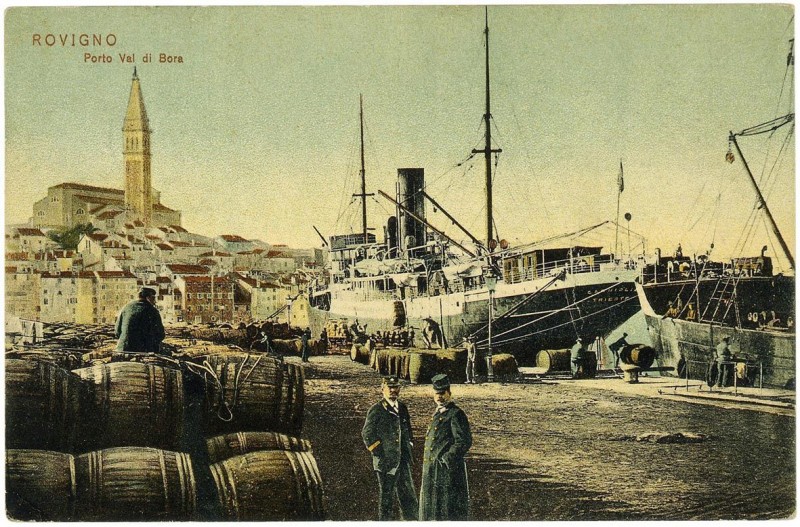Rovinj until the End of Middle Ages

Rovinj or Castrum Rubini was first mentioned in Cosmographia by the Anonymous from Ravenna. It is dated to the 7th century AD, with a number of geographic data pertaining to the 5th century AD from which Rovinj chronicler Benussi concludes that Rovinj was founded between the 3rd and 5th centuries AD.
Rovinj surroundings, according to archaeological findings, were inhabited in the prehistoric period - the Bronze and Iron Ages, when the culture of the Histrian tribe who lived in Istria and traded with the Greeks and Etruscans was at its peak. The most recent accidental finds indicate that the island where contemporary Rovinj is located (peninsula since 1763) was inhabited at the end of the 2nd and the beginning of the 1st millennium BC.
After a peaceful reign of the Roman Empire, while running away from incursions of the Visigoths, Huns, Goths and Byzantines, the ancient Romans in search of safety inhabited the islands of Mons Albanus, St. Catherine, St. Andrew and Cissa. The island of Cissa was first mentioned by Pliny the Elder and allegedly sank during a major earthquake in the second half of the 8th century.
Castrum Rubini, located where today the Church of St. Euphemia is standing, formerly the Church of St. George, became Ruigno, Ruginio, Ruvigno and survived devastating attacks from land and sea: the Slavs (Domagoj in 876), the Narentines (in 865 and 887) and the Saracens (in 819 and 842).
After the period of Byzantine rule Rovinj first fell under the Longboards and subsequently passed under the rule of the Franks. In feudal Istria Rovinj lost much of the autonomy of the old Roman municipalities, however, as an important city, which is testified by the fact that as castrum it takes part in the Assembly of Rižana in 804, it managed to get certain exemptions.
From the side of the town facing the sea it was protected by rocky gorges and from the mainland by high walls. Despite the stone fortifications it was, as other towns in Istria, repeatedly ravaged and burned. Istria as a bridge between the Apennines and the Balkans was of great importance to great civilizations of the West and East in their fight for primacy.
Charlemagne recognized the authority of the Aquileia patriarch and in 966 Rovinj was annexed into the Poreč bishopric, although, according to church organization, during the previous centuries it belonged to the Pula diocese.
During the 10th and 11th centuries Istria was ruled by the powerful feudal families of Germany who looked favourably on the political and economic empowerment of Venice.
Town administration, which comprised of the Citizens Council and the Assembly, led by a consul, struggled for autonomy as opposition to the feudal and ecclesiastical sovereign - the patriarch of Aquileia - who ruled since 1208, and Venice - an emerging naval force.
At one moment Rovinj sided with one power, and the next with the other, depending on the privileges they offered. In 1188 Rovinj signed a contract with Dubrovnik (Renovatio Pacis) in which both sides committed to trade and exchange goods.
During the 13th century Rovinj repeatedly clashed with western Istrian towns of Piran and Koper. Serenissima strengthened wishing to transform the northern Adriatic into Venetian Bay and Istria into its shield. Rovinj, with other Istrian towns, decided that the strong naval force will be a protector of its commercial and maritime interests, and, following the example of Poreč, Novigrad and Umag sided with Venice in 1283. Thus began the long period of Venetian rule. The Venetian Republic apparently gave communal freedom, but retained the right to nominate podestat, under whose jurisdictions were ecclesiastical, political, administrative, commercial, and other activities. Podestat was, of course, from Venice; Rovinj’s autonomy was limited, and only a few privileged families had the opportunity to participate in the Council. Judges, elected by the Council, acted as civil and criminal authorities together with the podestat.
Social division was simple. The population was divided into nobles and plebeians (nobili et popolani). This division was the foundation of all municipal forms of government: the Council and the Assembly. Over time, the Council was limited to a few noble families who participated in it by the right of inheritance. The mandate of the podestat or praetor lasted for a year, then for two years and since 1306 for 16 months. The officers elected were appointed by the Venetian Senate. Already at the beginning of the 15th century Rovinj had its statute divided into three books: the first regulates the organization of the administration, the second comprises civil law, property law, land, livestock, grazing, and the third book criminal law, penalties and taxes.
Venetian economy was mainly mercantile, and as a result of the growth of trade Rovinj experienced typical urban change. Artisans, merchants, and sailors begin to appear along with the existing fishermen and farmers. First fraternities were formed in the 14th century: landowners and farmers, sailors, stone carvers, fishermen, etc. Rapid development of maritime economy resulted in competitiveness between the cities and even in armed conflicts. Venice fought with Genoa, who in 1379 devastated and conquered Rovinj. The Genovese even took the bones of the town patron from the sarcophagus, but they returned them in 1401.
Central Istria was in possession of the Counts of Gorizia and in 1374 it fell, as Pazin County, under the Habsburg rule. The interests of two great powers clashed which often led to conflict. The Middle Ages brought another great misfortune - the plague. Rovinj, however, was partly spared due to its favourable climate.
